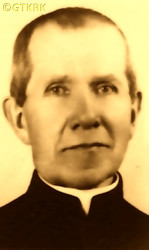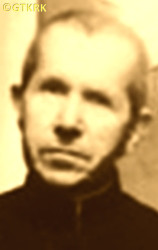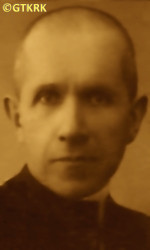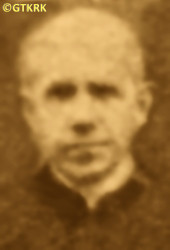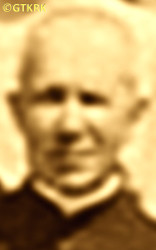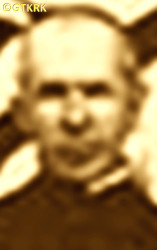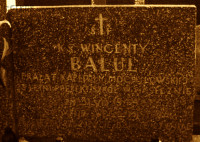Roman Catholic
St Sigismund parish
05-507 Słomczyn
85 Wiślana Str.
Konstancin deanery
Warsaw archdiocese, Poland
full list:
displayClick to display full list

searchClick to search full list by categories
wyświetlKliknij by wyświetlić pełną listę po polsku

szukajKliknij by przeszukać listę wg kategorii po polsku

Martyrology of the clergy — Poland
XX century (1914 – 1989)
personal data
surname
BALUL
forename(s)
Vincent (pl. Wincenty)
function
diocesan priest
creed
Latin (Roman Catholic) Church RCmore on
en.wikipedia.org
[access: 2014.09.21]
diocese / province
Mogilev archdiocesemore on
en.wikipedia.org
[access: 2013.06.23]
Warsaw archdiocesemore on
en.wikipedia.org
[access: 2013.05.19]
academic distinctions
Sacred Theology MA
honorary titles
Prelate‐cantor (Lat. praelati‐cantorus)more on
Prelate—cantor (Lat. praelati—cantorus)
(c. 1928 – c. 1932, Assumption of the Blessed Virgin Mary and St Stanislav the Bishop and Martyr RC archcathedral church, Mogilevtoday: Mogilev dist., Mogilev reg., Belarus
more on
en.wikipedia.org
[access: 2022.01.06])
Order of Saint Stanislav (Russian Empire) 3rd classmore on
Order of Saint Stanislav (Russian Empire) 3rd class
date and place
of death
31.08.1944

Piasecznotoday: Piaseczno gm., Piaseczno pov., Masovia voiv., Poland
more on
en.wikipedia.org
[access: 2021.07.29]
details of death
In 1919, during the Polish–Russian War of 1919‐1921, arrested in Vitebsk by the Russian Bolsheviks and sent to slave labor camps. Held, among others, in a slave labor camp organized in 05.1920 in an Orthodox monastery on the Solovetsky Islands, which was later transformed by the Russians into the first concentration camp of the Gulag system — the ITL SLON camp.
Maltreated and tortured.
Released in 1921, as a result of the Riga Treaty of 18.03.1921 ending the Polish–Russian War.
In the same 1921 crossed over to independent Poland and settled in the „Poniatówka” manor house in Piaseczno near Warsaw.
After the German and Russian invasion of Poland in 09.1939 and the start of World War¬II, during the German occupation, fell ill in 07.1944.
Placed in a Warsaw hospital, where was diagnosed with stomach cancer.
Shortly thereafter, on 01.08.1944, the Warsaw Uprising broke out and the hospital was bombed by the Germans.
Found and returned to Piaseczno, prob. by Hungarian soldiers serving alongside the Germans.
Shortly afterwards, due to arrests in neighboring Chyliczki — prob. in connection with the hunt for soldiers of the Home Army AK (part of the Polish Clandestine State), who on 02.08.1944 fought a fierce battle with the Germans near Pęcice, west of Warsaw, and who, in significant part, withdrew to the Chojnowskie Forests near Piaseczno (the Germans murdered over 91 captured members of this AK unit) — thrown out by the Germans from the „Poniatówka” manor house.
Perished in a private apartment, after a visit from the German Germ. Geheime Staatspolizei (Eng. Secret State Police), i.e. Gestapo, which ordered him to leave the town.
cause of death
lack of treatment
perpetrators
Germans
sites and events
Warsaw UprisingClick to display the description, GeneralgouvernementClick to display the description, Ribbentrop‐MolotovClick to display the description, Pius XI's encyclicalsClick to display the description, ITL SLONClick to display the description, Polish‐Russian war of 1919‐1921Click to display the description
date and place
of birth
18.07.1874

Sankt Petersburgtoday: Saint Petersburg city, Russia
more on
en.wikipedia.org
[access: 2020.07.31]
baptism
c. 1874

Sankt Petersburgtoday: Saint Petersburg city, Russia
more on
en.wikipedia.org
[access: 2020.07.31]
St Catherine of Alexandria RC churchmore on
en.wikipedia.org
[access: 2022.01.06]
presbyter (holy orders)
ordination
1899

Sankt Petersburgtoday: Saint Petersburg city, Russia
more on
en.wikipedia.org
[access: 2020.07.31]
St Catherine of Alexandria RC churchmore on
en.wikipedia.org
[access: 2022.01.06]
positions held
1921 – 1944
prefect — Piasecznotoday: Piaseczno gm., Piaseczno pov., Masovia voiv., Poland
more on
en.wikipedia.org
[access: 2021.07.29] ⋄ primary schools ⋄ St Anne RC parish ⋄ Warsaw‐extra‐Urbemdeanery name
today: Warsaw city pov., Masovia voiv., Poland RC deanery
1932 – 1939
chaplain — Chyliczkitoday: Piaseczno gm., Piaseczno pov., Masovia voiv., Poland
more on
en.wikipedia.org
[access: 2022.07.21] ⋄ Cecile Plater–Zyberk's Women's School of Farming
c. 1928 – 1932
Prelate‐cantor (Lat. praelati‐cantorus) — Warsawtoday: Warsaw city pov., Masovia voiv., Poland
more on
en.wikipedia.org
[access: 2021.10.09] ⋄ Cathedral Chapter ⋄ Mogilevtoday: Mogilev dist., Mogilev reg., Belarus
more on
en.wikipedia.org
[access: 2022.01.06], Assumption of the Blessed Virgin Mary and St Stanislav the Bishop and Martyr RC archcathedral church ⋄ Mogilev RC archdiocese
1925 – 1932
pro‐synodal judge — Warsawtoday: Warsaw city pov., Masovia voiv., Poland
more on
en.wikipedia.org
[access: 2021.10.09] ⋄ Archbishop's Metropolitan Court ⋄ Warsaw RC archdiocese
1916 – 1919
dean — Vitebsktoday: Vitebsk reg., Belarus
more on
en.wikipedia.org
[access: 2023.01.18] RC deanery
1916 – 1919
parish priest — Vitebsktoday: Vitebsk reg., Belarus
more on
en.wikipedia.org
[access: 2023.01.18] ⋄ St Anthony RC parish ⋄ Vitebsktoday: Vitebsk reg., Belarus
more on
en.wikipedia.org
[access: 2023.01.18] RC deanery
1899 – 1916
prefect — Daugavpilsform.: Dvinsk (1893‐1920)
today: Daugavpils urban mun., Latvia
more on
en.wikipedia.org
[access: 2020.07.31] ⋄ St Peter in Shackles RC parish ⋄ Daugavpilsform.: Dvinsk (1893‐1920)
today: Daugavpils urban mun., Latvia
more on
en.wikipedia.org
[access: 2020.07.31] RC deanery — i.a. in 1st and 2nd Town Gymnasium
till 1899
student — Sankt Petersburgtoday: Saint Petersburg city, Russia
more on
en.wikipedia.org
[access: 2020.07.31] ⋄ philosophy and theology, Imperial Roman Catholic Spiritual Academy (1842‐1918) — postgraduate specialised studies, on 20.05.1898 crowned with a Sacred Theology Candidate's degree, and on 14.06.1899 with a Sacred Theology Master's degree
till c. 1896
student — Sankt Petersburgtoday: Saint Petersburg city, Russia
more on
en.wikipedia.org
[access: 2020.07.31] ⋄ philosophy and theology, Metropolitan Theological Seminary
sites and events
descriptions
Warsaw Uprising: Lasted from 01.08.1944 till 03.10.1944. Was an attempt to liberate Polish capital from occupying Germans by the Polish Clandestine State — a unique in the history of the world political structure on the territories occupied by the Germans, effectively governing clandestinely in Poland — and by fighting on its behalf underground military units, mainly of Home Army (former Armed Struggle Association ZWZ) and National Armed Forced (NSZ). At the same time Russians stopped on purpose the offensive on all front, halted on the other bank of Vistula river and watched calmly the annihilation of the city, refusing even the mid‐landing rights to the Allied planes carrying weapons and supplies to the insurgents from Italy. During the Uprising Germans murdered approx. 200,000 Poles, mainly civilians. Approx. 200 priests and nuns died in fighting or were murdered by the Germans, many in mass executions. (more on: en.wikipedia.orgClick to attempt to display webpage
[access: 2013.08.17])
Generalgouvernement: After the Polish defeat in the 09.1939 campaign, which was the result of the Ribbentrop‐Molotov Pact and constituted the first stage of World War II, and the beginning of German occupation in part of Poland (in the other, eastern part of Poland, the Russian occupation began), the Germans divided the occupied Polish territory into five main regions. In two of them new German provinces were created, two other were incorporated into other provinces. However, the fifth part was treated separately, and in a political sense it was supposed to recreate the German idea from 1915 (during World War I, after the defeat of the Russians in the Battle of Gorlice in 05.1915) of creating a Polish enclave within Germany. Illegal in the sense of international law, i.e. Hague Convention, and public law, managed by the Germans according to separate laws — especially established for the Polish Germ. Untermenschen (Eng. subhumans) — till the Russian offensive in 1945 it constituted part of the Germ. Großdeutschland (Eng. Greater Germany). Till 31.07.1940 formally called Germ. Generalgouvernement für die besetzten polnischen Gebiete (Eng. General Government for the occupied Polish lands) — later simply Germ. Generalgouvernement (Eng. General Governorate), as in the years 1915‐1918. From 07.1941, i.e. after the German attack on 22.06.1941 against the erstwhile ally, the Russians, it also included the Galicia district, i.e. the Polish pre‐war south‐eastern voivodeships. A special criminal law was enacted and applied to Poles and Jews, allowing for the arbitrary administration of the death penalty regardless of the age of the „perpetrator”, and sanctioning the use of collective responsibility. After the end of the military conflict of the World War UU, the government of the Germ. Generalgouvernement was recognized as a criminal organization, and its leader, governor Hans Frank, guilty of war crimes and crimes against humanity and executed. (more on: en.wikipedia.orgClick to attempt to display webpage
[access: 2024.12.13])
Ribbentrop‐Molotov: Genocidal Russian‐German alliance pact between Russian leader Joseph Stalin and German leader Adolf Hitler signed on 23.08.1939 in Moscow by respective foreign ministers, Mr. Vyacheslav Molotov for Russia and Joachim von Ribbentrop for Germany. The pact sanctioned and was the direct cause of joint Russian and German invasion of Poland and the outbreak of the World War II in 09.1939. In a political sense, the pact was an attempt to restore the status quo ante before 1914, with one exception, namely the „commercial” exchange of the so‐called „Kingdom of Poland”, which in 1914 was part of the Russian Empire, fore Eastern Galicia (today's western Ukraine), in 1914 belonging to the Austro‐Hungarian Empire. Galicia, including Lviv, was to be taken over by the Russians, the „Kingdom of Poland” — under the name of the General Governorate — Germany. The resultant „war was one of the greatest calamities and dramas of humanity in history, for two atheistic and anti‐Christian ideologies — national and international socialism — rejected God and His fifth Decalogue commandment: Thou shall not kill!” (Abp Stanislav Gądecki, 01.09.2019). The decisions taken — backed up by the betrayal of the formal allies of Poland, France and Germany, which on 12.09.1939, at a joint conference in Abbeville, decided not to provide aid to attacked Poland and not to take military action against Germany (a clear breach of treaty obligations with Poland) — were on 28.09.1939 slightly altered and made more precise when a treaty on „German‐Russian boundaries and friendship” was agreed by the same murderous signatories. One of its findings was establishment of spheres of influence in Central and Eastern Europe and in consequence IV partition of Poland. In one of its secret annexes agreed, that: „the Signatories will not tolerate on its respective territories any Polish propaganda that affects the territory of the other Side. On their respective territories they will suppress all such propaganda and inform each other of the measures taken to accomplish it”. The agreements resulted in a series of meeting between two genocidal organization representing both sides — German Gestapo and Russian NKVD when coordination of efforts to exterminate Polish intelligentsia and Polish leading classes (in Germany called «Intelligenzaktion», in Russia took the form of Katyń massacres) where discussed. Resulted in deaths of hundreds of thousands of Polish intelligentsia, including thousands of priests presented here, and tens of millions of ordinary people,. The results of this Russian‐German pact lasted till 1989 and are still in evidence even today. (more on: en.wikipedia.orgClick to attempt to display webpage
[access: 2015.09.30])
Pius XI's encyclicals: Facing the creation of two totalitarian systems in Europe, which seemed to compete with each other, though there were more similarities than contradictions between them, Pope Pius XI issued in 03.1937 (within 5 days) two encyclicals. In the „Mit brennender Sorge” (Eng. „With Burning Concern”) published on 14.03.1938, condemned the national socialism prevailing in Germany. The Pope wrote: „Whoever, following the old Germanic‐pre‐Christian beliefs, puts various impersonal fate in the place of a personal God, denies the wisdom of God and Providence […], whoever exalts earthly values: race or nation, or state, or state system, representatives of state power or other fundamental values of human society, […] and makes them the highest standard of all values, including religious ones, and idolizes them, this one […] is far from true faith in God and from a worldview corresponding to such faith”. On 19.03.1937, published „Divini Redemptoris” (Eng. „Divine Redeemer”), in which criticized Russian communism, dialectical materialism and the class struggle theory. The Pope wrote: „Communism deprives man of freedom, and therefore the spiritual basis of all life norms. It deprives the human person of all his dignity and any moral support with which he could resist the onslaught of blind passions […] This is the new gospel that Bolshevik and godless communism preaches as a message of salvation and redemption of humanity”… Pius XI demanded that the established human law be subjected to the natural law of God , recommended the implementation of the ideal of a Christian state and society, and called on Catholics to resist. Two years later, National Socialist Germany and Communist Russia came together and started World War II. (more on: www.vatican.vaClick to attempt to display webpage
[access: 2023.05.28], www.vatican.vaClick to attempt to display webpage
[access: 2023.05.28])
ITL SLON: Russian Rus. Исправи́тельно‐Трудово́й Ла́герь (Eng. Corrective Labor Camp) ITL Rus. Солове́цкий ла́герь осо́бого назначе́ния Ла́герь (Eng. Solovetsky Special Purpose Camp) SLON — concentration and slave forced labor camp (within what was to become Gulag complex) — headquartered in Solovetsky Islands in Arkhangelsk Oblast. Founded on 13.10.1923 in a famous Orthodox monastery. In the 1920s, one of the first and largest concentration camps in Russia. The place of slave labor of prisoners — at forest felling, sawmills, peat extraction, fishing, loading work on the Murmansk Railway Main Line, in road construction, production of food and consumer goods, at the beginning of the construction of the White Sea ‐ Baltic canal, etc. The concept of the later system of Russian Gulag concentration camps prob. had its origins in the Solovetsky Islands camp — from there the idea spread to the camps in the area covered by the construction of the White Sea ‐ Baltic canal, i.e. ITL BelBaltLag, and from there further, to the entire territory of the Russian state. From the network of camps on the Solovetsky Islands — also called the Solovetsky Islands archipelago — prob. also comes the concept of the „Gulag Archipelago” created by Alexander Solzhenitsyn. It is estimated that tens to hundreds of thousands of prisoners passed through the Solovetsky Islands concentration camps. At its peak, c. 72,000 prisoners were held there: e.g. 14,810 (12.1927); 12,909 (03.1928); 65,000 (1929); 53,123 (01.01.1930); 63,000 (01.06.1930); 71,800 (01.01.1931); 15,130 (1932); 19,287 (1933) — c. 43,000 of whom were murdered, including the years 1937‐1938 when c. 9,500 prisoners were transported from the camp and murdered in several places of mass executions, including Sandarmokh, Krasny Bor and Lodeynoye Polye. Among them were many Catholic and Orthodox priests. After the National Socialist Party came to power in Germany in 1933, a German delegation visited the ITL SLON camp, to „inspect” Russian solutions and adopt them later in German concentration camps. It operated until 04.12.1933, with a break from 16.11.1931 to 01.01.1932, when it was part of and later became a subcamp of the ITL BelBaltLag camp. It operated as such until 1939 (from 1936 as a prison). (more on: old.memo.ruClick to attempt to display webpage
[access: 2024.04.08])
Polish‐Russian war of 1919‐1921: War for independence of Poland and its borders. Poland regained independence in 1918 but had to fight for its borders with former imperial powers, in particular Russia. Russia planned to incite Bolshevik‐like revolutions in the Western Europe and thus invaded Poland. Russian invaders were defeated in 08.1920 in a battle called Warsaw battle („Vistula river miracle”, one of the 10 most important battles in history, according to some historians). Thanks to this victory Poland recaptured part of the lands lost during partitions of Poland in XVIII century, and Europe was saved from the genocidal Communism. (more on: en.wikipedia.orgClick to attempt to display webpage
[access: 2014.12.20])
sources
personal:
www.kocham.piaseczno.infoClick to attempt to display webpage
[access: 2014.05.09], biographies.library.nd.eduClick to attempt to display webpage
[access: 2014.05.09], miniaturyhistoryczne.blogspot.comClick to attempt to display webpage
[access: 2019.02.02]
bibliographical:
„Fate of the Catholic clergy in USSR 1917‐1939. Martyrology”, Roman Dzwonkowski, SAC, ed. Science Society KUL, 2003, Lublin
original images:
www.przegladpiaseczynski.plClick to attempt to display webpage
[access: 2025.08.19], miniaturyhistoryczne.blogspot.comClick to attempt to display webpage
[access: 2019.02.02], www.facebook.comClick to attempt to display webpage
[access: 2025.08.19], commons.wikimedia.orgClick to attempt to display webpage
[access: 2025.08.19], miniaturyhistoryczne.blogspot.comClick to attempt to display webpage
[access: 2019.02.02], miniaturyhistoryczne.blogspot.comClick to attempt to display webpage
[access: 2019.02.02], miniaturyhistoryczne.blogspot.comClick to attempt to display webpage
[access: 2019.02.02], www.genealogia.okiem.plClick to attempt to display webpage
[access: 2014.05.09]
LETTER to CUSTODIAN/ADMINISTRATOR
If you have an Email client on your communicator/computer — such as Mozilla Thunderbird, Windows Mail or Microsoft Outlook, described at WikipediaPatrz:
en.wikipedia.org, among others — try the link below, please:
LETTER to CUSTODIAN/ADMINISTRATORClick and try to call your own Email client
If however you do not run such a client or the above link is not active please send an email to the Custodian/Administrator using your account — in your customary email/correspondence engine — at the following address:

giving the following as the subject:
MARTYROLOGY: BALUL Vincent
To return to the biography press below:
 Click to return to biography
Click to return to biography








